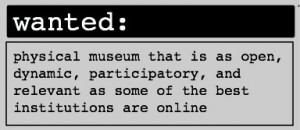Hiding behind a set-prop in the backyard of the Ohio Historical Society’s 1950s: Building the American Dream exhibit is a scenting generator. Aromas flow over the fabricated grass, tickling the noses of visitors. As museum participants continue through the exhibit, past the Lustron salesman and across the threshold of a generation in re-creation, the scent of “freshly baked bread” permeates throughout the enameled steel walls. Concealed, yet perceptually exposed, scenting generators enhance the museum environment in Ohio to draw in more visitors, extend conversations and help capture the elements of culture during the 50’s.
In the current political, economic and technological landscape, many museums are considering innovative designs and technologies to thrive. While there are many that oppose conforming to the new age of digitally run realities, many feel that this is an opportunity to capture segments of the population who see museum participation as an unwanted opportunity cost to more entertaining activities. We see examples of spectacular innovation in the digital world, where iPad integration or custom developed interfaces are used to enhance the engagement level of the common visitor, rather than speak to those who would have already attended. Social media has becomes a catalyst and creator for conversations between the museum’s content developers and the visitors themselves. But underneath all of this innovation, the mission of museums remains the same: education, relevance, connection and value. Granted, the internet and digital space is effective at beginning the conversation, but what all of this forgets is the roots of experience: sensory stimulation within a physical space.
Memory creation is formed by the footsteps of perception. Each sight, sound, smell and tactile piece of information define each individual’s involvement within their environment. And when we’re talking about the labyrinth of experience, there is no one element of sensory data that can offer a clearer picture than the other; it is a culmination of them all. We are not empty vessels to be filled, but rather enter into the museum space with a partly constructed canvas and a large amount of sensory data goes into painting our realities.
Scenting generators are representative of a new way of experiencing what we’ve been looking at for thousands, hundreds or maybe just tens of years. These kinds of sensory technologies are meant to lay in the shadows, yet capture the elements of culture that we miss when we choose a passive perception. Like most innovation in the museum space, it is not meant to take over the art, but enhance the visitor’s experience of it.
A large part of what museums do is capture elements of our collective, subjective reality for us all to engage in, learn from, change from. The intention is to cultivate, collect and inspire. The conversation should not begin with the questions, “Why is innovation coming into my museum?!” But, “How can we enhance and engage on a whole new level?”
Sensory technologies or atmospherics, like scenting generators, offer museum curators and exhibit designers a resource for a new kind of experience. Something as subtle as the scent of “freshly baked bread” can float through an old Lustron house, yet these hidden catalysts begin the most important conversations. “They smell the bread and they’re like ‘Oh my goodness!’ and they start talking about their grandmother,” Bill Mahon, the Ohio Historical Society’s Head of Exhibit Design explains. Our experience with our history is not a certain kind of activity. It’s a progression, a dynamic reaction. One that we would argue is largely based on a large culmination of sensory data.






